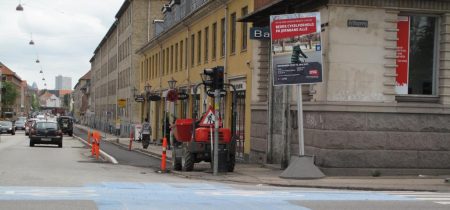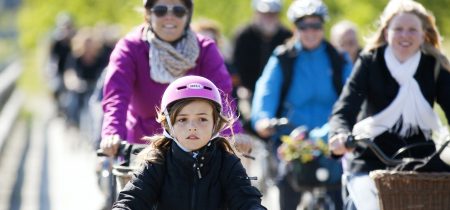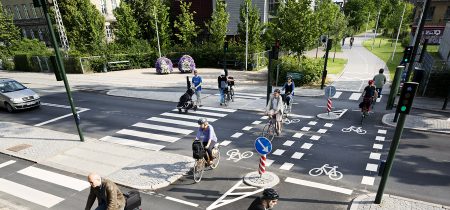Planning for cycling promotion
 In the capital region of Denmark local authorities and the regional administration cooperate to promote cycling by establishing cycle superhighways across municipal boundaries. This is one of many initiatives which have been successful in creating an increase in bicycle traffic in the capital region. Photo: Cycle superhighways , capital region of Denmark.
In the capital region of Denmark local authorities and the regional administration cooperate to promote cycling by establishing cycle superhighways across municipal boundaries. This is one of many initiatives which have been successful in creating an increase in bicycle traffic in the capital region. Photo: Cycle superhighways , capital region of Denmark. A bicycle action plan can help ensure the local authority’s overall aims and visions for cycling promotion and at the same time give planners a tangible tool for concrete actions and measurable outcomes.
By Maya Sig Vestergaard and Trine Bunton, Rambøll
The art of cycling promotion
There are many advantages to encouraging more people to use the bicycle for their everyday transport since cycling supports many of the local authority’s visions and objectives. (See the article Bicycle Planning is a Joint Affair in the present collection.)
The majority of local authorities work on promoting cycling through various measures. However, in many parts of the country it is difficult to increase the bicycle share of commuter trips, and unfortunately it seems that on the national level people are using bicycles less and less for their everyday transport. In the larger cities such as Copenhagen, Aarhus and Odense an improvement is detectable, but the situation in the rest of Denmark is less encouraging.
- Trend in bicycle traffic index 2007-2017.Weather can have a major impact on bicycle traffic trends, and contributes to the large annual fluctuation.
- Denmark’s personal transport statistics (person/km) distributed according to transport mode. Bicycle/moped 30. 3.4% Bus 8.6% Train 7.8% Boat/ferry 0.4% Airplane 0.4% Car and van/MC/moped 45/taxi 79.4%. Source: Danish Road Directorate.
Left: Trend in bicycle traffic index 2007-2017.Weather can have a major impact on bicycle traffic trends, and contributes to the large annual fluctuation. Right: Denmark’s personal transport statistics (person/km) distributed according to transport mode. Source: Danish Road Directorate.
This is partly due to cultural causes: We commute more and no longer feel the need to find a workplace near home. In the period between 2008-2016 the average commuting distance rose by 10.3% to 20.9 km. And outside the larger cities neither the bicycle nor collective transport can compete with the car when it comes to travel time.
We are also willing to travel further to reach our preferred leisure activities. This also applies to our children so the car is in frequent use after work, too. Many families do their major shopping twice a week and again the car is the easiest and most practical choice of transport mode when heavy shopping bags need to be carried home. Furthermore more people choose a private school, which is often further away than the district school.
The issue of traffic safety also plays a role for choice of transport mode, especially when it comes to our children. The increasing number of cars on the roads means that many people perceive traffic as more dangerous despite the fact that the number of registered accidents has probably never been lower.

- The number of traffic casualties and fatalities has been falling over the past 10 years. Source: Statistics Denmark. Blue: Total personal injury. Green: Fatality. Grey: Serious injury. Orange: Mild injury.
In other words, getting more people to cycle isn’t simply a matter of establishing a new cycle track here and there. It requires a long- term, dedicated effort across professional sectors. A broadly anchored bicycle action plan with concrete, measurable objectives is needed in order to keep up with developments.
Make cycling promotion work concrete and effective
When you wish to promote cycling through a bicycle action plan it can be hard to know where to begin and what the plan should include. In addition there are many interfaces within the local authority where the distribution of tasks is unclear, and it can be difficult to decide where specific tasks should be anchored and who should do what. Working on a bicycle action plan helps identify and address many such issues.
In order to ensure that the bicycle action plan is anchored in the local authority’s overall visions and objectives it’s a good idea to start by finding out what they are, and then work downwards on the level of abstraction and upwards on the level of detail in the six steps illustrated in figure 4 and discussed in detail below:
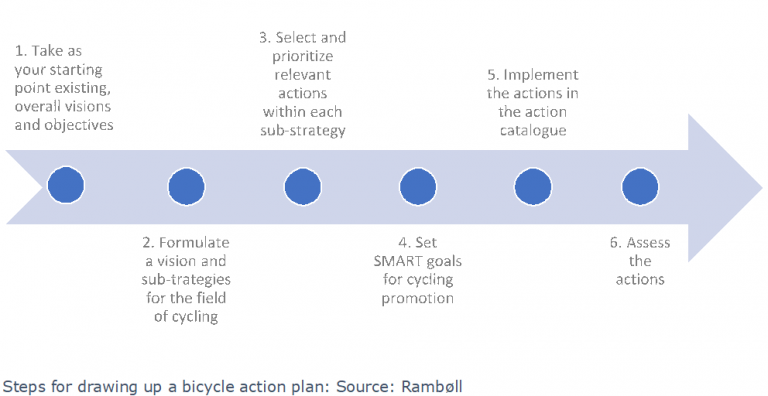
1. Take as your starting point existing, overall visions and objectives
It is essential to understand that cycling promotion is not merely the job of the technical administration. Cycling has too great a potential for positive effects in many different areas to be reduced to a question of transport. See the article Bicycle Planning is a Joint Affair in the present collection.
If the local authority is successful in getting more people to cycle, this will support many other visions and objectives that the local authority considers important. It is crucial to create an awareness across administrations and political groups that cycling promotion is worth cooperating on, and is relevant for everyone. This is why you should take as your starting point existing, overall visions and objectives and clearly communicate how cycling is a vital element to achieve these ambitions. The different administrations need to feel ownership of the mission to promote cycling.
2. Formulate a vision and sub-strategies for the field of cycling
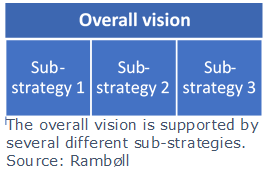 To ensure ownership, the different administrations across professional sectors also need to formulate a vision and sub-strategies for the field of cycling. This can be done in a workshop, for example, where different professional fields meet and agree on what they want in relation to the field of cycling (vision) and how to go about achieving it (sub-strategies).
To ensure ownership, the different administrations across professional sectors also need to formulate a vision and sub-strategies for the field of cycling. This can be done in a workshop, for example, where different professional fields meet and agree on what they want in relation to the field of cycling (vision) and how to go about achieving it (sub-strategies).
When the work is broken down into a single overall vision and supportive sub-strategies, it becomes more manageable, and it’s easier to identify the actions that will ensure that the vision is achieved.
3. Select and prioritize relevant actions within each sub-strategy
A bicycle action plan should be concrete and use different measures for different sub-strategies.
It is crucial to consider the individual measure’s cost, both in terms of funding and human resources, and to have a time horizon for the implementation. The time horizon should be weighed against the available resources. It’s usually necessary to prioritize since resources are rarely available to address all objectives at once.

- Aalborg, Aarhus and Odense base their work on a four step principle: 1. Influence traffic needs and choice of transport mode.
2. Effective use of the existing infrastructure. 3. Improve the existing infrastructure. 4. New construction. Source Odense municipality
In addition, you need to think about what works best in the specific context. What works in larger cities does not necessarily have the best effect in more rural surroundings. The focus should be on getting the maximum amount of cycling promotion for the least amount of money.
Most local authorities have long lists of desired cycle tracks but establishment of cycle tracks is not the only way to promote cycling. Behaviour modification measures through educational projects and campaigns can also have an impact on the bicycle share, and these are usually less costly than construction.
In a limited municipal budget it makes sense to consider what you can do that doesn’t require new construction. Go for the low hanging fruit first.
Planners in Odense, Aarhus and Aalborg base their mobility planning work on a four step principle. The aim is to change transport behaviours and optimize the use of the existing infrastructure (see figure). Construction of a new cycle track, for example, is the last resort and only used when it’s the best solution to bring about the desired change.
Odense municipality discusses its division of actions in ’Handlingsplan for Mobilitet og Byrum’.
Each of the steps of the Four Step Principle is divided into categories. The individual action is assessed in relation to the degree to which it supports the visions and objectives for mobility, traffic safety, health, urban development, business and growth, and smart city.
Aarhus municipality bases its cycling promotion work on 22 different focus areas:
- A cohesive cycle route network
- New high class track links
- Accessibility
- Bicycle parking facilities
- Behaviours and communications
- We cycle together in Aarhus (Sammen om cycling i Aarhus)
- Cycling all year round
- Traffic safety and security
- Combination trips
- Way-finding
- High quality design and implementation
An overall strategy and a number of actions to support the strategy are formulated for each focus area. See Aarhus Kommunes cykelhandlingsplan fra 2017
Aalborg municipality identifies five focus areas: commuter cycling, multi-modality, children on bikes, traffic safety, and leisure cycling. Various actions are identified within each focus area intended to increase the number of cyclists and improve conditions for people who already cycle. For further information see: Aalborg Kommunes Cykelhandlingsplan.
No matter what actions are considered relevant to achieve the overall vision, it is essential to measure project progress, which hopefully will be favorable.
4. Set SMART goals for cycling promotion
Objectives can be formulated for cycling promotion within each sub-strategy or action. It is important to be able to measure progress and show the investment has borne fruit. Measurable progress helps ensure political support for future investment in cycling promotion.
In order to monitor developments and hopefully the increase in bicycle traffic and a positive trend in citizen’s perception of cycling conditions, planners should work with SMART objectives:

Here is an example: You wish to increase the number of commuting trips by bicycle in a specific larger city by 20% compared to the present level over the next 20 years.
Aalborg municipality works with SMART objectives in relation to bicycle traffic:
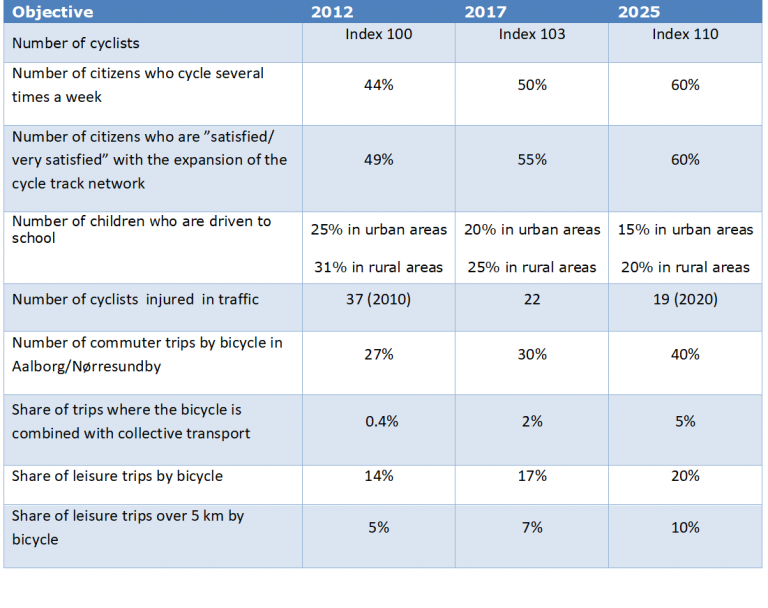
It’s easy to measure quantitative objectives such as numbers and percentages, but SMART objectives also deal with qualitative issues such as citizen opinions and surveys.
It’s important to set realistic expectations as to what constitutes successful bicycle promotion and improved citizen satisfaction with the given investment. A citizen may not feel that cycling conditions have been improved or begin to cycle more unless the new cycling infrastructure is placed precisely where his own activities are.
However, cycling promotion investments are usually good business from the cost-benefit point of view even though the increase in the number of cyclists is limited and citizen attitudes remain unchanged. Step 6 discusses how actions can be assessed.
5. Implement the actions in the action catalogue
When it’s time to implement actions, the order of implementation should be considered. It’s important to get off to a good start. This creates positive energy among the involved colleagues and other stakeholders, and can have a positive impact on subsequent actions.
If a project is relatively easy to carry out, if funding is not an unknown quantity, and there is a demand for the project among citizens and other stakeholders, it is likely to be a success and a good story. A good start can mean that the bicycle action plan’s other actions will be positively received by politicians, citizens, the media, and other administrations.
In order to ensure anchorage and ownership across the various municipal administrations it may also be a good idea to involve colleagues from the non-technical administrations and even to appoint some of them as action project managers. In smaller or medium sized municipalities where there is only one staff member to handle cycling promotion work, a delegation of tasks may mean that the staff member has the opportunity to discuss matters with colleagues, and doesn’t feel that cycling promotion is solely his or her responsibility.
6. Assess the actions – and communicate the advantages of cycling promotion
It’s finally time to assess the initiatives. It can be difficult to measure the precise effect of each individual action without an exhaustive evaluation. Nevertheless it’s worth considering whether this is possible and what questions should be asked that will address the given concerns. In addition to considering to what extent the SMART objectives have been achieved, it may be a good idea to look at cost-benefit since this is precisely what shows whether or not it makes sense to continue to invest in cycling promotion.
Several Danish local authorities have demonstrated the positive effects of investing in cycling in so-called Bicycle Accounts. Monetary values are assigned to the different types of benefits derived from the local authority’s investments in cycling promotion, for example, health and the environment. Bicycle accounts usually contain the results of citizen surveys among the local authority’s citizens.
Road investment often measures cost-benefit in terms of time saved, and bicycle accounts are a way of putting cycling promotion investment on an equal footing with road investment, and comparing the cost-benefits.
Ideally opinion surveys should be carried out and bicycle accounts should be drawn up every two years in order to monitor developments on an on-going basis. The on-going follow-up helps maintain interest, ensures a positive focus on initiatives to promote cycling, emphasizes why cycling promotion investment is a good idea, and helps fulfill some wishes for cycling infrastructure.
Examples of Danish local authorities’ bicycle accounts
- City of Copenhagen: Bicycle Account 2018 (English)
- Gladsaxe Munipality: Borgerundersøgelse 2015 – En undersøgelse af borgernes transportvaner og holdninger til forholdene for cyklister (Danish)
- Randers Municipality: Cykelregnskab 2015 (Danish)
- Ringkøbing-Skjern Municipality: Fjorden Rundt – Cykelregnskab, januar 2018 (Danish)
The many wishes for cycling tracks
Many Danish local authorities are already working on a cycle track plan, which usually also includes soft initiatives such as educational campaigns. The plan identifies the locations where the local authority plans to establish future cycle tracks. The cycle track planning process varies from authority to authority.
In certain local authorities all citizen requests for cycle tracks are included and prioritized. Since the number of cycle track wishes usually exceeds the allocated funds, the list of cycle track projects is often very long and can appear daunting. Citizens may find it depressing that their wish for a particular cycle track is at the very bottom of a long list, and will not happen for a long time if at all.
On the other hand citizens may feel that their concerns have been heard when the wished for cycle track is actually on a list. Perhaps the citizen will understand that there may be a greater need for a cycle track elsewhere. Or citizens may bring pressure to bear on the political level, and demand that the listed prioritization needn’t be final, or they may simply call for more cycle track funding.
Sometimes the temporary solution of a cycle lane can last for years until a cycle track appropriation is available. In Odense, for example, a stretch was improved for DKK 10,000 all inclusive.
Cycle track projects may also be initiated by the traffic planning administration when planners perceive the need to link existing cycle tracks or major overall destinations or traffic hubs. The cycling infrastructure may also play a role for socially disadvantaged areas and provide greater mobility to groups that are otherwise limited by lack of mobility.




